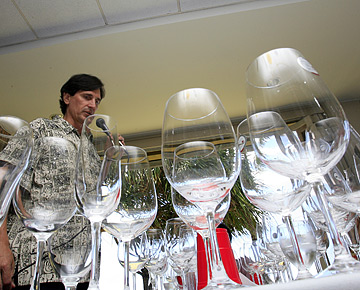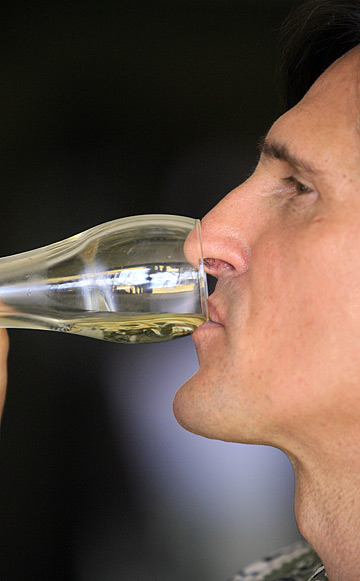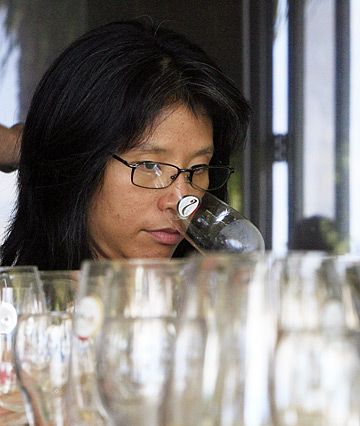Raise your glasses
New stemware that "breathes" intrigues experts and novices alike
CAN STEMWARE really alter the taste of wine?
A room full of skeptics quickly became believers when side-by-side comparisons made it impossible for oenophiles to ignore: New breathable Eisch wine glasses, gaining popularity in Europe and recently introduced in the United States, could challenge Riedel, long the industry's gold standard. Both German companies offer a variety of beverage-specific glasses, but new technology takes Eisch models in a different direction.
Ronn Wiegand, the first person in the world to earn master of wine and master sommelier titles (on his first attempts), led a group of sommeliers and wine merchants through a taste test of four wines in standard crystal and Eisch breathable glassware at the Waialae Country Club last week. And even the most unsophisticated palate in the room -- mine -- was impressed.

JAMM AQUINO / JAQUINO@STARBULLETIN.COM
Master of wine and master sommelier Ronn Wiegand talks to a group about Eisch breathable glasses, a new player in the high-end stemware market.
|
|
A 2003 HDV Chardonnay was one of the selections. "Amazing," said Wiegand, swirling the wine under his nose. "It smells really good in both glasses. But on my first pass through, I get 50 percent more aroma in the breathable glass. It's like somebody gave me an extra helping."
In the standard glass, the "wine seems disjointed. I notice the alcohol, I notice an astringency, some bitterness ... and some oak. It doesn't seem to be integrated. But in the breathable glass, the nose is automatically together. I get peach, vanilla, roasted nut, grapefruit. It's no comparison on the palate. It's suddenly brought around into a supple, beautifully balanced wine. It tastes like a much, much better wine."
Wine merchant Lyle Fujioka raised his eyebrows and simplified the analysis: "It's pretty dramatic!"
Todd Ashline, dining room manager and sommelier at Chef Mavro, said later: "I was impressed; I would get some for myself. There's definitely a difference in the palate or the nose -- not necessarily both."
Fujioka, who has been using the glasses for six months, said he watched a winemaker visiting from California taste his own creation from an Eisch glass, "and he freaked out." From that moment, all conversation revolved around the glass rather than the wine.
"It does what it says it's supposed to do, which is enhance the wine," said Fujioka. "It was, in my opinion, stunning. This glassware is so new that we're getting ahead of Napa, which boggles me."
CALLING IT a breathable glass elicits images of a porous structure, but that does not appear to be an accurate description, as it looks no different from any other piece of fine crystal.
The mysterious process of creating each glass is closely guarded for competitive reasons. Terms such as "oxygenizing," "ionizing," "atomic change" and "activated glassware" get thrown around, though not even Wiegand is privy to the actual details. He is not a broker, but he has a vested interest: Eisch will soon release a Wiegand-designed signature model.
Business allegiance aside, Wiegand's reputation in the wine community is impeccable, and it's clear he caters to nobody. Even his publication, "Restaurant Wine," has never accepted advertising dollars.
"I like the glasses so much that I want my name on them," said Wiegand, who has used dozens of Eisch glasses daily for the past two years. "That's how strongly I believe in them. I would never jeopardize my reputation; I've never sold out."
Though the average wine drinker probably won't invest in a set of Superior Burgundy from Eisch or the hand-blown Sommelier series from Riedel, exploring whether the composition of a glass or accelerating the "opening" of the wine changes the tasting experience is an exciting prospect -- even for those unconvinced that Eisch can compete with a product that has succeeded for nine generations.
"Glassware is a very subjective thing," said master sommelier Roberto Viernes, a Star-Bulletin wine columnist. "The beauty of having the Eisch glasses out there is that people have options. It truly shows that people are more aware of what wines they are drinking, and how they are drinking them. That brings a great thing to the party and to the industry."

JAMM AQUINO / JAQUINO@STARBULLETIN.COM
How many beverage-specific glasses should a bon vivant own? Ronn Wiegand says, "Nobody on Earth needs more than three wine glasss -- a red, a white, and a sparkling."
|
|
The simplest way to experiment with the Eisch stemware's effectiveness is to open the wine bottle when you are ready to taste. "Allowing the wine to sit in the glass for two or three or four minutes is the equivalent of letting it aerate for about an hour," said Wiegand. "But that's too simplistic. It does something more to the wine. It enhances the characteristics of the wine so that you can see more clearly what's already there."
The best news for restaurateurs who must cover the costs of breakage may be that the lead-free crystal is durable and can be cleaned in the dishwasher. To demonstrate, Wiegand knocked over a glass in a gesture that would have shattered a typical model. Some epicures, however, quietly noted that buttressed weak spots created a top-heavy, less elegant glass when swirling the wine -- a matter of individual preference. And priorities, said Wiegand.
NEW TECHNOLOGY in an established enterprise is always controversial. Some wine enthusiasts who asked not to be identified expressed cautious admiration but said they were not yet convinced, and certainly had no plans to abandon their Riedel collections. They agreed the Eisch glasses improved two out of five wines. But questions remained -- not the least of which centered on the concern that the breathable glass would rush the wine to an early demise, a charge that Wiegand denied.
Viernes, also director of education for Southern Wine & Spirits, which sells Riedel glassware, said he has sampled the Eisch glasses. "I thought they were good. But ultimately, I think the difference was not great enough to justify carrying them."
Riedel sales have grown steadily over the past five or six years, especially with the introduction of the new stemless O Series. Viernes explained that the material of the glass and the wine's aeration are only part of the story. "The shape of the glassware, the way it feels in your hand, the way you tilt your head back and the way the wine hits your palate have a big influence on the way it tastes."
WIEGAND, who tastes 5,000 newly released wines every year, said that Eisch tested the glasses for three years and addressed all apprehensions before gaining enough confidence to penetrate the commercial market.
But he conceded that the results are not electrifying in every case.
"It may enhance (an inexpensive wine) a little bit, but it's not going to make a $10 wine a $100 wine," said Wiegand. In the case of HDV, a $50 Chardonnay, "suddenly we've been kicked up to $75."
And what about mature wines? The Eisch glasses "will enhance an older wine, provided the wine isn't already too old start with," said Wiegand. "If it's already on the decline, no glass is going to help it. The glass is not a wine doctor. It's not going to save the patient. The patient will die anyway."
In the end, he said confidently, "the glasses will earn their own reputation."

JAMM AQUINO / JAQUINO@STARBULLETIN.COM
SOURCES
Eisch breathable stemware sells for $10 to $20 per glass. These stores stock them or will have them soon:
Fujioka's: Market City Shopping Center, lower level, 739-9463
HASR Wine Co.: 31 N. Pauahi St., 535-9463
Simply Grape: 841 Bishop St. Suite 153, 447-9000
Tamura's Fine Wines & Liquors: 1216 10th Ave., 735-7100
Vintage Wine Cellar: 1249 Wilder Ave., 523-9463
Wine Stop: 1809 S. King St., 946-3707
|
|

